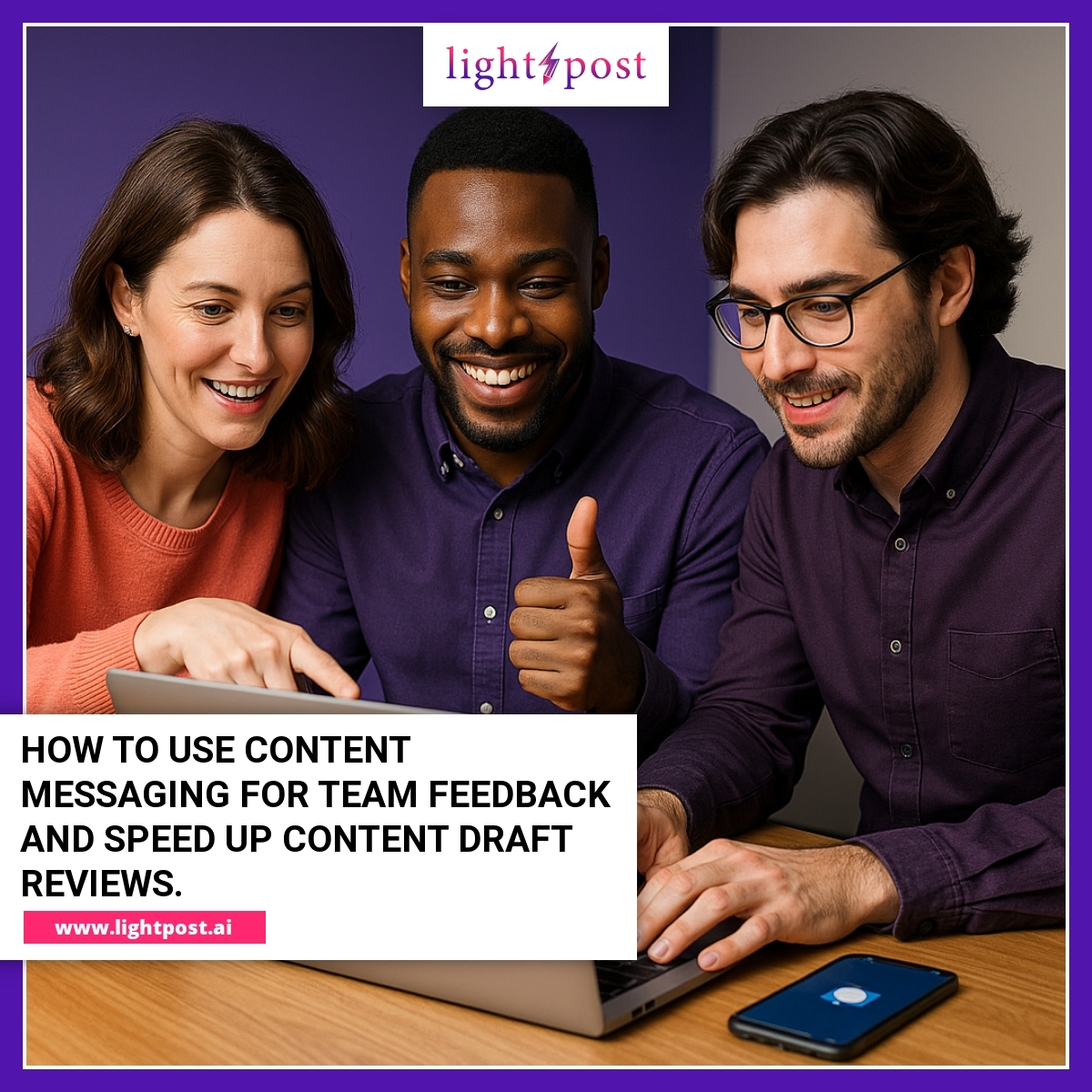Templating made simple: how Lightpost turns high-performing post formats into reusable content blueprints for your business
Ever felt like social media eats into every spare minute? Most business owners start off with a fresh idea and boundless energy—then find themselves buried in half-finished drafts and endless platform switches. In today’s crowded schedule, creating effective posts “from scratch” just doesn’t scale.
Every unshared post, inconsistent caption, and late update drags you further from your next real business result. The worst part: It’s not your fault—most businesses waste hours reinventing what already works. Meanwhile, competitors quietly speed ahead using content templates to lock in structure, save time, and stay on brand, every time.
Lightpost makes content creation radically easier. By turning your best-performing posts into automated, reusable templates—optimized for each channel and for your brand—Lightpost flips the script, freeing you up for high-impact work instead of repeat typing. Here’s how to use content templates to do better work in a fraction of the time (and yes, you’ll see exactly what the pros do differently).
How do content templates actually boost marketing results for small businesses?
The question, “how do content templates actually boost marketing results for small businesses?,” anchors one of the top search intents right now: what are content templates. The answer is simple—these templates turn chaos into consistency, helping you go from blank page to published post with less stress and better results.
Using content templates slashes your idea-to-publish time. Set up a master outline for the post types you share again and again—think “Monday Motivation” or “Product Tips”—and watch your workflow go from sluggish to streamlined overnight. With a strong content creation strategy, you’ll set the tone and structure, so posts pump out faster than ever before. According to new industry data, Lightpost’s automation lets marketing teams skip lengthy drafting and go straight to publishing, while centralizing all tasks in one spot—meaning no more chasing down scattered files or hand-offs.*
Teams that rely on templates never worry about awkward tone shifts due to burnout or hand-offs, since brand language gets built right in. Experts quickly make “core” content templates for blogs, social, and newsletters, then tweak, duplicate, and optimize as results come in. Rookie mistake: treating every new post as a one-off project. Instead, lean on proven structures that convert and simply swap in fresh stories or new research—suddenly everyone on the team speaks in one brand voice, marching toward shared goals. Visit Lightpost for easy access to ready-to-use format starters that speed up onboarding and hand-offs.
(Here’s what goes sideways when everyone writes from scratch.)
When every post starts from a blank document, the result is a patchwork—no two posts look or sound alike. Common failures include missing CTAs, inconsistent messaging, off-brand phrases, and hours wasted searching for standard links or company blurbs.
- Disjointed content flow often means a growth stall, since no two campaigns align, and past learnings go ignored.
- Research hours rack up fast when teams redo the same work—unstandardized strategy means multiple rounds of review for basics (headers, intros, disclaimers).
- Fix this by mapping bottlenecks using analytics, then building content templates to target slow-down points in your marketing process. Pull proven bits from previous launches and turn recurring pain into speed.
Looking for ways to identify why campaigns stall and how to repair weak points with ease? The next section explores how to transform your highest-performing posts into reusable blueprints—without the rookie errors.
What does it take to turn top-performing posts into reusable content templates?
To turn top-performing posts into reusable content templates, analyze winning posts: break down the repeating headings, favorite story tricks, image placements, and CTA formats. Then, architect templates that capture that structure so you can duplicate results instead of lucking into them.
Start by digging into audience engagement metrics—ask which posts drive the most interaction or shares. Keep elements that age well (like classic product intros or story-driven CTAs), and update the fluff that fizzles. Build out a template library, sorting by campaign type or platform, so your team can instantly find the right reusable content blueprint for every project. Pro move: annual template reviews. The best teams schedule time to update language, calls to action, and visuals, never letting the template go stale. Always test, measure, and refine your content templates to match changing audience tastes. Need real-world proof? Agencies report that Lightpost automates this process, letting them scale content with less manual work, tighter brand standards, and a lot more speed.*
(Want to spot your template sweet spot? Here’s how tracking saves hours.)
- Use platform analytics or Lightpost’s built-in feedback to flag which post types keep people reading or clicking—then make those winners your base templates.
- Change one thing at a time in your master template, like swapping the order of FAQs or trying a two-sentence intro. Track each tweak, saving what works, so every next campaign gets stronger.
- For extra impact, document which tweaks produced jumps in content performance and build a log of wins for instant reference.
Now, if you’re wondering just how much easier this process can get, let’s check out why automating templates with Lightpost gives you the advantage—no more headaches, no more version hunts.
Why does Lightpost make content templates easier than manual systems?
Lightpost makes content templates easier than manual systems by automating every step of the blueprint process. Instead of copy-pasting or digging through old email threads, Lightpost lets you convert any winning post into a fully editable, sharable template—ready to use on every channel, every time.
Customizing is simple: Use dynamic fields to swap in stats, dates, or product names so each post feels fresh without losing consistency. Workflows let your entire team see drafts, comment, and approve in-app, eliminating the “who has the right file?” drama. And when you update the master template, every user sees the latest—no risk of outdated copy floating around. Workflow collaboration becomes seamless, so bottlenecks disappear. Lightpost integrates tightly with existing CMS and publishing tools, making scaling your content blueprint effortless.*
(No more “who’s got the latest version?” drama—just click and go.)
- Tired of copy-pasting meta data, URLs, image credits, or tags for every post? Drop these recurring tasks right into your automated content templates. Anyone picking up the template knows exactly what to fill out and what to check off.
- Preview every post as your readers will see it—Lightpost’s publish-ready preview reduces last-minute mistakes or branding slip-ups.
- Workflow efficiency is not just a nice-to-have: it’s the difference between missing deadlines and building a steady, trusted online voice.
As your content volume ramps up, the question isn’t just about speed—it’s about locking in that professional tone you’ve built. So, how do templates hold your brand voice steady when you need it most?
How can content templates keep your brand voice consistent across every channel?
Content templates keep your brand voice consistent across every channel by embedding your unique tone, message order, and compliance reminders right inside the format. With Lightpost, templates can be tailored for LinkedIn, Instagram, or newsletters—all while keeping the core identity intact.
Brand teams use Lightpost’s AI to optimize content templates for platform quirks, adjusting length, image ratios, or hashtags in a click. This modular approach ensures you always sound like you, no matter who writes or where it’s posted. Onboarding becomes straightforward: New hires “learn the voice” by filling in proven templates, not by guessing. Brand guides built into the content make compliance automatic. With another major platform unveiling persona-driven template editing this year*, it’s clear: locking in voice and style up front helps companies keep messages clear—even as they scale diverse platforms.
(Look, no brand mishaps—and it actually gets more creative.)
- Use modular templates: swap out opens, CTAs, or visuals easily without touching your base structure. Brand voice stays locked in—even if product launches or info changes overnight.
- Lightpost templates open up creative “zones”—areas in each post for writers to add their own twist, while the framework keeps everything in line.
- Never risk a rogue color palette or forgotten tone update; Lightpost syncs updates instantly, so the latest creative content templates are always up to spec.
Of course, just having templates isn’t a win—using them right is everything. What mistakes do most teams make with content templates, and how does Lightpost keep you on track?
So, what are the most common mistakes people make with content templates (and how does Lightpost avoid them)?
Common content template mistakes sabotage results slowly: teams reuse outdated info, skip SEO best practices, or apply last year’s content templates to new audiences. Those errors creep in unnoticed and quietly tank post engagement or search ranking. Make quarterly template reviews a habit: check every header, link, and call to action for freshness. Swap in new examples, update visuals, and run SEO score scans.
Avoid “template fatigue” by regularly refreshing text blocks and images. With Lightpost, all edits to templates update for everyone—no rogue copies, no obsolete stats. Lightpost’s automated workflows mean that updates aren’t just pushed live—they’re tracked, so you spot exactly when and how a version went wrong or if a SEO slip-up cost you. Blueprint-style template management, now standard across leading AI platforms*, has made staying updated an expected best practice.
(Here’s how to spot stale templates before anyone else does.)
- Set up a one-click audit in Lightpost to scan for broken links, outdated stats, or funky layouts. If you find a problem, update it once—everyone sees the fix.
- Build a feedback loop: after each campaign, your team rates the template’s clarity, speed, and brand fit. This user-led template optimization means no outdated files stick around.
- Log your favorite templates and retire underperformers. Track which ones get used (or skip over) to refine your library, so it gets smarter every month.
It gets better. With strong templates in hand, quality doesn’t need to drop as you scale out to new platforms. How does Lightpost let you do more with less—without sending your standards off a cliff?
Is it possible to use content templates to scale multi-platform content without losing quality?
It’s possible to use content templates to scale multi-platform content without losing quality—Lightpost creates platform-optimized versions in bulk, ensuring SEO, voice, and formatting all dial in with each new post batch. Set task assignments directly within Lightpost, so posts roll out according to plan and nothing falls through the cracks.
Lightpost’s analytics flag strong and weak performers, so you don’t guess what works for each network—templates update as audience and engagement shift. Drop in channel-specific links or hashtags, so calls to action and copy tweak automatically for higher engagement. Recent data shows agencies leveraging Lightpost now meet multi-brand demands at scale, with steady, reliable content output and workflow simplicity built in.*
(Scaling doesn’t mean spamming, here’s how to boost quality while you ramp up.)
- Build each platform’s requirements—like special hashtags for Instagram or shorter intros for Facebook—right into your templates for platform-specific content.
- Let Lightpost suggest quarterly template updates, using real feedback to refine your approach so audience fatigue never sets in and content scaling gets smarter, not sloppier.
- Assign, track, and tweak all content schedules directly inside Lightpost’s easy content calendar, making bulk content creation painless for even lean teams.
“Efficiency is doing better what is already being done,” said Peter F. Drucker, and in 2025, content templates—made simple and scalable by Lightpost—are the fastest route to marketing that’s both fast and consistent. If better results with less chaos sound good, it’s time to give them a try.
Ready to spend less time on what to post and more on growing your business? Try Lightpost for a free demo and see how easy consistent, branded, and creative social media really can be.
[*SOURCES: Lightpost, Lightpost, Blueprint]





